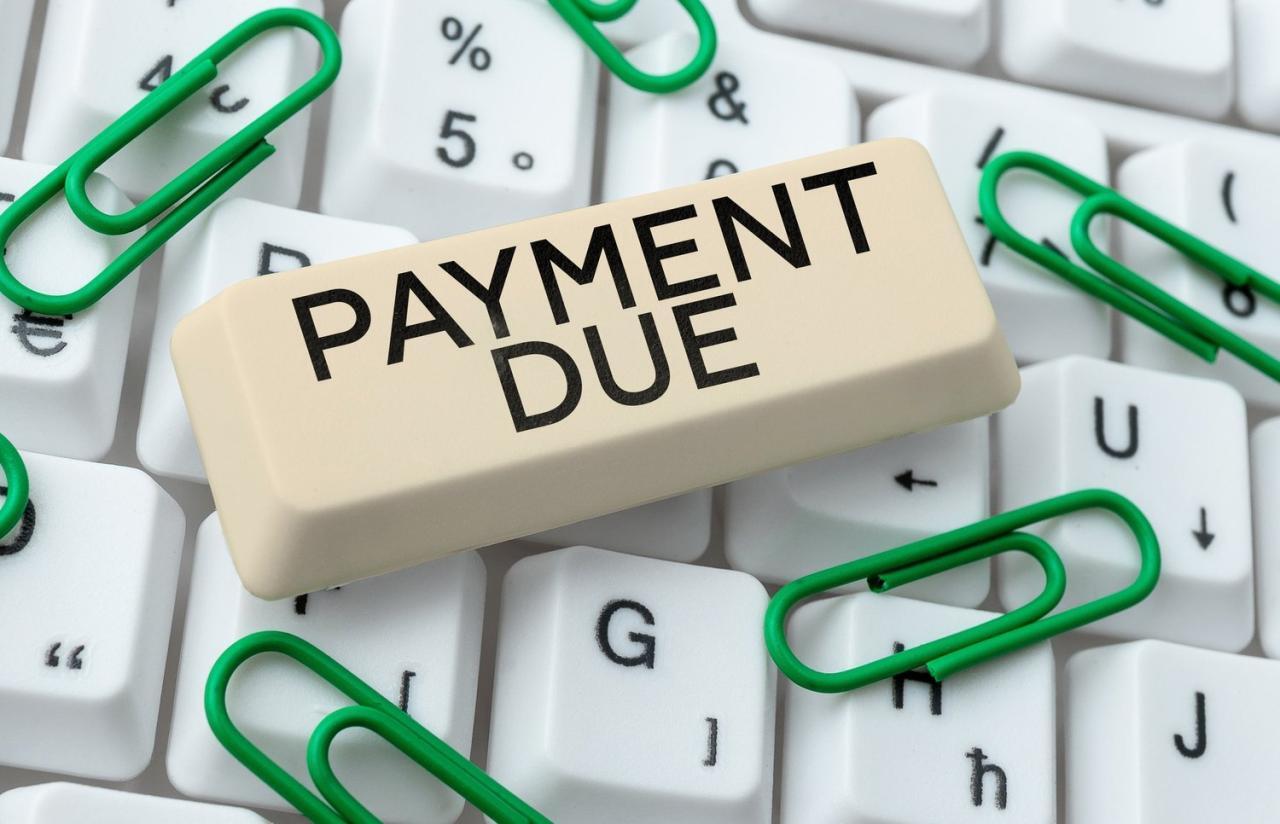Managing client payments is crucial for any business. Understanding payment terms, anticipating potential issues, and establishing a clear follow-up process are essential for maintaining healthy client relationships and ensuring timely revenue. This comprehensive guide delves into the intricacies of handling late payments, providing actionable strategies and insights for effective communication and dispute resolution.
From defining clear payment expectations in contracts to understanding the root causes of delays, this guide offers a practical approach to navigating the complexities of late payments. It emphasizes the importance of proactive communication, ensuring that both parties remain informed and satisfied throughout the process.
Understanding Client Payment Terms

A crucial aspect of maintaining healthy client relationships is a clear understanding of payment terms. This section delves into common payment terms Artikeld in contracts, providing examples of various schedules and highlighting the importance of precise definitions to avoid potential disputes. Thoroughness in this area safeguards both parties’ interests.Payment terms in contracts act as a roadmap for the financial transaction.
They Artikel the specifics of when and how a client will fulfill their payment obligations, protecting both the service provider and the client. Well-defined payment terms prevent misunderstandings and potential conflicts.
Common Payment Terms in Contracts
Payment terms are often detailed in contracts, ensuring both parties are on the same page. They specify the amount, due dates, and acceptable payment methods. These details should be meticulously documented. Failure to do so can lead to ambiguity and disagreements.
- Fixed Payment Schedules: Common fixed payment schedules include monthly installments, payment upon project completion, or payments based on predetermined milestones. For example, a monthly retainer for ongoing consulting services is a fixed schedule, whereas a project completion payment is suitable for one-off projects.
- Milestone-Based Payments: These payment schedules delineate specific milestones or deliverables. Payment is triggered upon achieving each milestone. This is often used for complex projects where progress can be clearly defined, ensuring the client receives value as the project evolves. For instance, a website development project might be divided into design, development, and testing milestones, with payments released upon successful completion of each.
- Project Completion Payments: This method involves payment only upon the successful and complete delivery of the agreed-upon project. It is suitable for projects with a clear start and end point. A well-defined scope of work is essential in this case.
Comparison of Payment Methods
Different payment methods offer varying advantages and disadvantages. A careful consideration of these factors is critical when outlining payment terms.
| Payment Method | Pros | Cons |
|---|---|---|
| Cash | Simple, avoids processing fees | Not ideal for large transactions, lacks a record |
| Check | Traditional, widely accepted | Slower processing, potential for delays, less secure |
| Wire Transfer | Fast, secure for large amounts | Requires bank details, potentially high fees |
| Credit Card/Debit Card | Convenient, widely accepted, readily trackable | Processing fees, security concerns if not handled properly |
| Online Payment Platforms | Secure, efficient, detailed transaction records | Fees may apply, dependence on internet access |
Identifying the Root Cause of Late Payments
Understanding the reasons behind late payments is crucial for effective client management and maintaining healthy business relationships. Identifying the root cause allows for targeted solutions, preventing future issues and fostering stronger communication. A proactive approach to addressing potential payment problems is key to maintaining a positive working environment.
Common Reasons for Late Payments
Late payments from clients can stem from various underlying factors. Cash flow issues, often beyond the client’s control, can be a significant contributor. Economic downturns, unexpected expenses, or fluctuating market conditions can all impact a client’s ability to meet payment deadlines. Misunderstandings regarding project scope, deliverables, or payment terms can also lead to delays. Project delays, unforeseen circumstances, or challenges during the execution phase can push payment schedules.
Finally, internal administrative issues within the client’s organization, such as bottlenecks in their payment processing system, can also contribute to late payments.
Importance of Proactive Communication
Proactive communication is paramount in addressing potential payment issues. Open and timely communication with clients allows for early identification of potential problems and facilitates collaborative solutions. This proactive approach can prevent escalating issues and maintain positive client relationships. By establishing clear communication channels and protocols, businesses can mitigate the risk of late payments and foster trust.
Strategies to Anticipate and Prevent Late Payments
Anticipating and preventing late payments requires a multifaceted approach. Clearly defined payment terms and schedules, communicated upfront and documented in contracts, are essential. Regular project updates and progress reports can keep clients informed and provide visibility into the project’s status. This transparency can help anticipate potential delays and address them collaboratively. Implementing robust invoicing systems, enabling prompt reminders, and fostering strong client relationships are all proactive measures to minimize the risk of late payments.
Potential Causes and Mitigation Strategies
| Potential Cause | Mitigation Strategy ||—|—|| Cash flow issues | Discuss payment terms flexibility (e.g., phased payments, extended deadlines) with the client. Offer alternative payment options (e.g., invoice financing) if applicable. || Misunderstandings regarding project scope/deliverables | Ensure thorough project scoping and documentation. Use clear, concise language in contracts and project plans. Provide regular updates and proactively address any questions or concerns from the client.
|| Project delays | Implement a robust project management system. Establish clear milestones and deadlines. Proactively communicate any potential delays to the client and explore solutions together. Develop contingency plans. || Internal administrative issues (client-side) | Maintain open communication channels and actively seek information about any potential issues affecting the payment process.
Confirm the client’s internal payment procedures. || Unexpected circumstances | Discuss potential scenarios in advance. Build in flexibility within contracts to account for unforeseen issues. Develop contingency plans that can be easily implemented if required. |
Communicating with Clients About Late Payments

Effective communication is crucial when dealing with late payments. A clear and professional approach can often resolve the issue quickly and maintain a positive working relationship. This section Artikels strategies for communicating with clients about overdue invoices, emphasizing politeness, professionalism, and a proactive approach.Understanding the root cause of the late payment, as discussed previously, is vital before initiating communication.
This allows for tailored and empathetic communication.
Communication Templates for Addressing Late Payments
Effective communication templates demonstrate professionalism and a proactive approach to resolving payment issues. Below are examples of polite and professional communication templates, suitable for different levels of urgency.
- Initial Gentle Reminder (within 1-2 days of due date):
“Dear [Client Name],This is a friendly reminder that invoice [Invoice Number] for [amount] is due on [due date]. Please let us know if you require any further information or have encountered any unforeseen circumstances.
Sincerely,
[Your Name]” - Follow-up Reminder (within 3-5 days of due date):
“Dear [Client Name],This is a follow-up regarding invoice [Invoice Number] for [amount], due on [due date]. We haven’t yet received payment. Please contact us if you require any clarification or if there are any issues that need addressing.
Sincerely,
[Your Name]” - Formal Reminder (within 7-10 days of due date):
“Dear [Client Name],This letter serves as a formal reminder regarding invoice [Invoice Number] for [amount], due on [due date]. Payment is now overdue. Please remit payment within [number] days, or contact us to discuss possible payment arrangements.
Sincerely,
[Your Name]”
These templates provide a framework; adapt them to suit the specific circumstances of each client and situation.
Maintaining a Positive and Constructive Tone
Maintaining a positive and constructive tone is essential throughout the communication process. Avoid accusatory language or threats. Focus on solutions and collaboration. Express understanding and willingness to work with the client to resolve the issue. A calm and professional tone fosters a more productive dialogue.
Handling Sensitive Conversations About Overdue Payments
Sensitive conversations require tact and empathy. Listen actively to the client’s explanation for the delay. Acknowledge their concerns and avoid interrupting. Focus on finding a mutually agreeable solution. Avoid becoming defensive or arguing.
Emphasize that your goal is to resolve the issue.
Strategies for Effective Communication Approaches
Different communication methods have varying levels of effectiveness. The chosen method should align with the nature of the issue and the client’s preferences.
| Communication Method | Effectiveness | Suitable Scenarios |
|---|---|---|
| Efficient for initial and follow-up reminders. Leaves a record. | Routine reminders, general inquiries, requests for clarification. | |
| Phone Call | Effective for resolving complex issues, building rapport. | Sensitive conversations, negotiating payment arrangements, clarifying concerns. |
| Formal Letter | Demonstrates seriousness and formality. Suitable for legal record-keeping. | Serious delinquency, potential legal action. |
Careful consideration of the communication method ensures the most effective and respectful approach to each client.
Establishing a Payment Follow-up Process

A well-defined payment follow-up process is crucial for maintaining healthy client relationships and ensuring timely payment. This structured approach minimizes the risk of late payments escalating into larger issues and fosters a professional, proactive communication style. Implementing a clear procedure allows for consistent handling of payment discrepancies, ultimately protecting your business’s financial health.A robust payment follow-up process involves a series of escalating communication steps designed to gently remind clients of their payment obligations while maintaining a professional demeanor.
This structured approach helps to prevent disputes and ensures that payment issues are resolved efficiently.
Step-by-Step Procedure for Following Up on Late Payments
A systematic approach to following up on late payments is essential. This structured process provides a framework for handling payment issues effectively and efficiently. The following steps Artikel a clear path for dealing with late payments.
- Initial Reminder (Within 1-3 days of due date): Send a polite email or automated message reminding the client of the outstanding invoice. This initial contact should reiterate the due date and provide a clear statement of the amount owed. Include a concise and professional tone. For example, “Dear [Client Name], this is a friendly reminder that invoice [Invoice Number] for [Amount] is due on [Date].
Please let us know if you have any questions or require further clarification.”
- Follow-up Reminder (Within 5-7 days of due date): If no response is received after the initial reminder, send a second email or automated message reiterating the due date and amount owed. This follow-up should include a slightly firmer tone, but maintain a professional and courteous approach. For example, “Dear [Client Name], this is a follow-up regarding invoice [Invoice Number] for [Amount]. The payment is still outstanding.
Please respond if you require further clarification or have already made the payment. We appreciate your prompt attention to this matter.”
- Formal Notice (Within 10-14 days of due date): If the client hasn’t responded to the follow-up reminder, send a formal notice outlining the payment terms and the consequences of non-payment. This notice should be clearly worded and highlight the potential repercussions, such as account suspension or collection efforts. For example, “Dear [Client Name], this formal notice concerns invoice [Invoice Number] for [Amount]. Payment is still outstanding.
Failure to remit payment by [Date] may result in suspension of services or further action as Artikeld in our terms and conditions.”
Timeline for Follow-up Actions
A well-defined timeline helps ensure timely and consistent follow-up actions. This structured approach provides a framework for addressing late payments effectively. The table below Artikels a suggested timeline for follow-up actions.
| Day | Action | Next Steps |
|---|---|---|
| Due Date + 1-3 | Initial Reminder | Send a polite email reminder. |
| Due Date + 5-7 | Follow-up Reminder | Send a second email reminder, maintaining a professional tone. |
| Due Date + 10-14 | Formal Notice | Send a formal notice, outlining payment terms and consequences. |
| Due Date + 15-21 | Escalation | Escalate to accounts receivable or legal counsel, if necessary. |
Importance of Documenting Communication
Comprehensive documentation of all communication is vital for tracking the process and providing evidence in case of future disputes. This detailed record allows for a clear understanding of the communication history.
- Detailed records: Maintain detailed records of all communications with the client regarding the late payment, including dates, times, and contents of emails, phone calls, and other correspondence.
- Proof of delivery: Use email tracking tools to ensure that communications are successfully delivered. Include copies of any correspondence in your records.
- Timeline of actions: Create a clear timeline of all actions taken to follow up on the late payment. This timeline should include the date of each communication, the recipient, and the content of the message.
Escalation Process
A clear escalation process is essential for handling persistent late payments. This structured approach ensures that payment issues are addressed effectively and professionally.
- Account Receivable Involvement: If the late payment persists despite follow-up efforts, escalate the matter to the accounts receivable department. They will have the expertise and resources to manage the situation more directly.
- Legal Counsel (if necessary): In extreme cases where repeated attempts at collection fail, consider involving legal counsel to pursue the debt recovery process. This is usually reserved for substantial amounts or recurring issues.
Handling Payment Disputes and Resolution

Addressing payment disputes proactively and professionally is crucial for maintaining positive client relationships and ensuring timely payment. A well-defined process for handling disputes allows for a fair resolution while minimizing potential legal issues. Understanding the root cause of the dispute is often the first step towards a satisfactory outcome.Effective dispute resolution involves a structured approach that balances the needs of both the client and the service provider.
This involves clear communication, careful documentation, and a willingness to negotiate to find mutually acceptable solutions. Early intervention is key to preventing disputes from escalating and impacting future business relationships.
Strategies for Resolving Payment Disputes
A proactive approach to resolving payment disputes is vital for preserving client relationships and ensuring financial stability. This section Artikels strategies that can be employed to address and resolve payment disputes efficiently.
- Active Listening and Understanding: Actively listening to the client’s perspective and understanding their reasoning behind the dispute is paramount. This approach fosters a collaborative environment, enabling a more productive dialogue. By understanding their concerns, a more targeted resolution can be achieved.
- Reviewing the Contract: A thorough review of the agreed-upon payment terms and conditions is essential to pinpoint any discrepancies or misunderstandings. The contract serves as a critical reference point, ensuring all parties are aligned on the agreed-upon terms.
- Offering Alternative Payment Plans: In cases where a client experiences temporary financial hardship, exploring alternative payment plans can be a mutually beneficial solution. This might involve a payment schedule, extending the due date, or other flexible options that accommodate the client’s circumstances while ensuring the service provider is compensated fairly.
- Negotiating a Compromise: A willingness to negotiate and find a compromise can often resolve disputes amicably. This could involve adjusting payment amounts or timelines, leading to a mutually acceptable outcome.
- Seeking Mediation: In complex or highly contentious situations, involving a neutral third party mediator can facilitate communication and help both parties reach a resolution.
Escalation to Legal Counsel
The decision to escalate a payment dispute to legal counsel should be made judiciously, only when all other avenues for resolution have been exhausted. This process should be clearly Artikeld in the initial contract.
- Documentation and Evidence Gathering: Maintaining meticulous records of all communication, contracts, invoices, and supporting documents is crucial. These records provide a detailed history of the dispute and support the legal case if necessary.
- Consultation with Legal Counsel: Consulting with legal counsel allows for an assessment of the situation, ensuring the legal process is handled effectively and efficiently. They can provide guidance on the legal options available, potential outcomes, and the required steps.
- Legal Process Initiation: The legal team will guide the process of initiating legal action, such as filing a lawsuit or pursuing other legal remedies, while maintaining ethical and legal standards.
Maintaining Clear Records
Comprehensive documentation throughout the dispute resolution process is critical for both internal record-keeping and potential future legal proceedings.
- Detailed Documentation of Communication: Maintaining detailed records of all communications with the client, including emails, phone calls, and meeting notes, is crucial. This provides a complete timeline of events and interactions.
- Copies of Contracts and Invoices: Ensuring all relevant documents, such as contracts, invoices, and payment records, are organized and easily accessible, is essential. This ensures all parties have a clear understanding of the agreed-upon terms.
- Chronological Log of Events: Maintaining a chronological log of all events related to the dispute is invaluable. This log will include dates, times, descriptions of interactions, and any relevant supporting documents.
Negotiating Payment Terms
Negotiating payment terms requires a balanced approach that considers both the client’s situation and the service provider’s needs. This approach should be undertaken with careful consideration and understanding.
- Identifying Potential Solutions: Brainstorming potential solutions that address the client’s concerns while ensuring the service provider receives fair compensation is vital. This often involves finding a mutually acceptable compromise.
- Developing a Proposal: Formulating a proposal outlining the agreed-upon payment terms and conditions is necessary. This ensures that all parties are aware of the agreed-upon solution and its specifics.
- Agreement and Documentation: A formal agreement on the negotiated payment terms, including the revised payment schedule, should be documented in writing. This protects both parties involved in the agreement.
Preventing Future Late Payments
Proactive measures are crucial for minimizing late payments and fostering strong client relationships. Implementing robust payment procedures and clear communication can significantly reduce the likelihood of future issues. This section explores strategies for enhancing payment collection and maintaining positive client interactions.
Strategies for Improving Payment Collection Procedures
Effective payment collection procedures are vital for maintaining a healthy cash flow. These strategies aim to streamline the process, improve transparency, and foster a positive client experience.
- Establish clear and concise payment terms from the outset. Clearly outlining payment schedules, due dates, and accepted payment methods in contracts minimizes ambiguity and sets expectations.
- Utilize online payment platforms. Online payment portals offer convenience for clients and facilitate secure and timely payments, reducing the likelihood of delays due to processing or mailing.
- Employ automated reminders. Automated reminders, sent via email or text message, gently nudge clients towards timely payments, reducing the need for manual follow-ups and potential misunderstandings.
- Offer multiple payment options. Providing options like online transfers, credit cards, or checks enhances client convenience and caters to different payment preferences, thereby promoting promptness.
- Maintain regular communication. Proactive communication about payment terms and schedules, especially in larger or more complex projects, keeps clients informed and reduces the possibility of unforeseen delays.
Importance of Regularly Reviewing and Updating Payment Policies
Payment policies should not be static. Businesses must adapt to changing market conditions, client expectations, and internal processes to maintain a robust payment collection system.
- Regularly review and update payment policies to ensure they remain aligned with industry best practices and internal procedures.
- Assess client feedback to identify areas where payment policies might be improved.
- Adapt to evolving technologies and client preferences. Incorporating online payment options, for instance, demonstrates a commitment to client convenience.
- Consider economic factors. Economic fluctuations may necessitate adjustments to payment terms or policies. Understanding these factors and adapting policies accordingly can help prevent financial strain on both the business and the client.
Examples of Contract Clauses Addressing Payment Terms and Penalties for Late Payment
Clear contract clauses are essential for defining payment expectations and outlining consequences for non-compliance.
“Payment is due within [number] days of invoice date. Late payments will incur a penalty of [percentage]% interest per month on the outstanding balance.”
“Invoices are due [date]. A late payment fee of [amount] will be applied for each invoice that is not paid within [number] days of the due date.”
Table Illustrating Benefits of Implementing Preventative Measures
Implementing preventative measures can significantly improve payment collection efficiency and reduce late payments.
| Preventative Measure | Benefits |
|---|---|
| Clear payment terms in contracts | Reduces misunderstandings, establishes expectations, and minimizes disputes. |
| Automated reminders | Prompts clients to make timely payments, reduces follow-up efforts, and enhances efficiency. |
| Multiple payment options | Increases client convenience, accommodates various preferences, and encourages prompt payment. |
| Regular policy reviews | Ensures policies remain current, responsive to market changes, and reflect best practices. |
Legal Considerations
Late payments from clients can have serious legal implications. Understanding these implications is crucial for protecting your business’s interests and ensuring a smooth and legally sound collection process. Proper documentation and adherence to relevant laws are paramount.Navigating the legal landscape of late payments requires careful consideration of potential penalties, statutes of limitations, and contractual agreements. A proactive approach to understanding and mitigating these risks is essential for avoiding costly legal disputes.
Legal Implications of Late Payments
Late payments can lead to various legal issues, including breach of contract, financial penalties, and potential litigation. A breach of contract occurs when a party fails to fulfill its obligations under a legally binding agreement, such as a sales contract or service agreement. This can expose the business to legal action from the client, including claims for damages or breach of contract.
Relevant Laws and Regulations
Various laws and regulations govern late payments, depending on the jurisdiction and the specific contract. These laws typically Artikel procedures for resolving disputes and imposing penalties for non-payment. Examples include consumer protection laws, commercial codes, and state-specific regulations that may address late payment practices within specific industries.
Potential Penalties for Non-Payment
Penalties for non-payment can vary significantly depending on the contract, the jurisdiction, and the specific circumstances. These penalties can include interest charges, late fees, and, in severe cases, legal fees. In some jurisdictions, non-payment may lead to the filing of a lawsuit and the possibility of a judgment against the client. It’s vital to understand the applicable laws and regulations in your specific jurisdiction to assess potential penalties.
Importance of Consulting Legal Counsel
Consulting with legal counsel is highly recommended when dealing with significant late payments or complex payment disputes. Legal counsel can provide expert advice on the applicable laws and regulations, assess the potential risks, and guide the business through the legal process. This consultation is crucial for ensuring that the collection process is conducted ethically and legally, avoiding any potential legal repercussions.
Legal counsel can also help draft and review contracts to include clauses that protect the business from late payments and provide clear mechanisms for resolving disputes.
Last Word
In conclusion, successfully handling late payments requires a multifaceted approach that combines clear communication, proactive measures, and a well-defined process. By establishing robust payment terms, anticipating potential problems, and employing effective follow-up procedures, businesses can mitigate the negative impacts of late payments and maintain positive client relationships. A strategic approach, coupled with a commitment to transparency and professionalism, is key to resolving payment issues efficiently and preventing future problems.